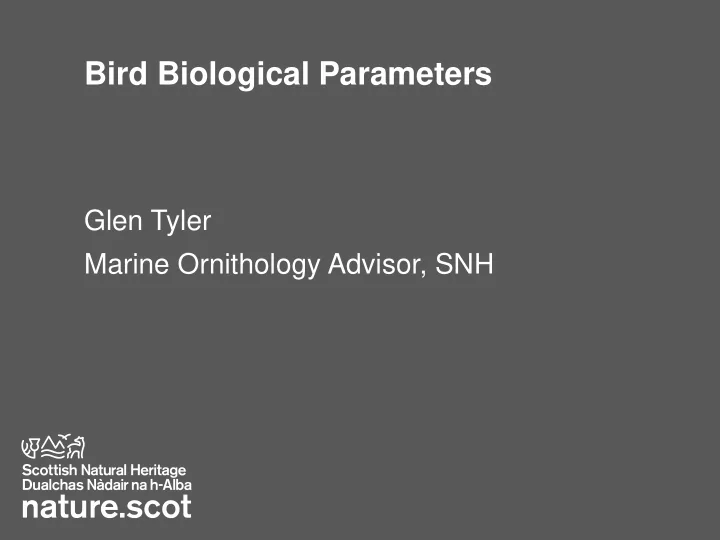

Bird Biological Parameters Glen Tyler Marine Ornithology Advisor, SNH
What is being covered? • Approaches and resources required for modelling • Highlight key references for parameters (e.g. flight speeds, bird lengths, nocturnal activity, PVA) • Specify changes/updates from previous Rounds (has evidence significantly changed to justify updates to flight speed, height, nocturnal activity). • Emerging / new papers or issues
For Collision Estimation Flapping or Gliding flight ? Gliding is more precautionary ‘Famous’ gliders are large Procellariformes. Gannet is modelled as gliding, other species as flapping. There is no particular reference for this, has been agreed through dialogue prior to assessment.
For Collision Estimation How Big is the bird? Both wingspan and body length required. Bird size varies between individuals, with often bi-modal (sexual) distribution for a species.
For Collision Estimation Shiny App has values already How Big is the bird? included (origin of these values not clear). Band Spreadsheet (deterministic) takes values from BTO bird facts
For Collision Estimation How fast is it flying? 2 sources of flight speed (until recently) Alerstam et al 2007 Pennycuik 1997 Pennycuik has estimates for many Flight Speed is an important species (in UK context). important parameter for collision risk estimation. Bowgen and Cook gives flight speeds in Table A1 – ‘True’ and ‘Straight Line’
For Collision Estimation ORJIP BCA study (Skov et al 2018), How fast is it flying? at Thanet OWF measured flight speeds by Radar and Laser rangefinder. ‘In the field’ measures and comparatively large sample size. True speed should be used for ‘blade crossing’ speed. Incorporates some behavioural aspects. Skov estimates reduce collision Straight Line speed predictions. should be used for ‘flux’ calculation. A new source - BTO NERC tracking data for CRM project (nearing finalisation).
For Collision Estimation Masden (2015) showed that flight How high is it flying? height is as important as avoidance rate in the overall risk calculation At sea flight heights have proved difficult to gather. LIDAR appears to offer a technologically robust method, but is only ‘proof of concept’ at this stage. Flight height curves from Johnston et al 2014 for generic use Project specific flight heights can still be used. Full evaluation required of method.
For Collision Estimation Nocturnal or Diurnal? Some birds are more active after dark than others, but most are substantially less active than during the day. Therefore, in theory, collision risk is lower at night. For gannet this is complete (Furness GPS and accelerometer data is et al. 2018). becoming available to reveal how much nocturnal flying different species 8% breeding season, 3% non- do. breeding season. Increments of 25%, so 0% for model input. Other species yet to be fully reviewed Astronomical twilight (Forsythe et al 1995)
For Population Modelling The Population Model (PVA) is required to provide metrics for assessment. SNH wish to see ratio metrics (‘counterfactual’ of final population size and ‘counterfactual’ of population growth rate). NE PVA tool http://publications.naturalenglan d.org.uk/publication/492699507 3073152 CEH / MS regional models To fit Semi-Integrated Population Models (SIPM) a good level of data completeness is required. May not available for all colonies. Bespoke models – using demographic information from Horswill and Robinson (2015). BTO 667
Thank you www.nature.scot @nature_scot
Recommend
More recommend